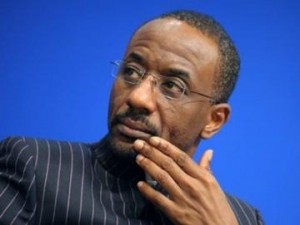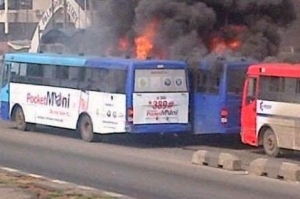When the Raffia-rich town of Ikot Ekpene LGA in the present Akwa Ibom State was chosen by the colonial British Government as the birth place to experiment their own pattern of grassroots local government administration in British West Africa and Africa in 1951, the political legendary, late Chief Robert Udoka Umoinyang emerged the first local government council chairman in the continent of Africa.
According to records, the late chief during his career line had at a point in time worked under Tony Blair, former British PM, during his (Blair’s) tenure as a District Officer in the then Ikot Ekpene District Council.
In this very rare and special interview, Madam Adiaha Udo-Udo R. U. Umoinyang, the only surviving wife of the historic council boss who died in 1972 and first lady of the pioneer council, recalled memories of the good old days in the British colonial era and declared that she is delighted to be alive today to also witness local government administration that her husband started 63 years ago, blossom and spread across the 36 states to become 774 in the country, insisting that it is worth celebrating. Excerpts…
According to records, the late chief during his career line had at a point in time worked under Tony Blair, former British PM, during his (Blair’s) tenure as a District Officer in the then Ikot Ekpene District Council.
In this very rare and special interview, Madam Adiaha Udo-Udo R. U. Umoinyang, the only surviving wife of the historic council boss who died in 1972 and first lady of the pioneer council, recalled memories of the good old days in the British colonial era and declared that she is delighted to be alive today to also witness local government administration that her husband started 63 years ago, blossom and spread across the 36 states to become 774 in the country, insisting that it is worth celebrating. Excerpts…
Can you recall memories of your good old days as the pioneer first lady of the pioneer Local Government Council in West Africa, nay Africa?
Yes, of course! I may not remember all, but I will try. I remember I got married to late Chief Robert Umoinyang at a tender age. Having graduated successfully alongside other big names like late Dr. Akanu Ibiam from the famous Norman College, a post-primary institute at Bonny in Port Harcourt Province, my husband served as a teacher at various schools, including, Ahoada College in Rivers State, Government School in Ikot Ekpene, Teachers Training College, TTC, Uyo in1932 (now University of Uyo) and Ibibio State College, Ikot Ekpene (1946) before he joined politics on retirement in 1951.
What prompted your husband’s involvement in politics?
On his retirement from the education sector in 1950, my husband was sent on a six-month course to study Native Administration (Local Government Administration) at the nation’s premier university (University of Ibadan) on British government scholarship. This was in preparation to climb the political rostrum the following year. I remember he was elected and sworn-in as the first local government council chairman on April 11, 1951 and later an Honourable member of the Eastern Region House of Assembly, Enugu, representing Annang Province in 1952. He was the National Vice-President of Ibibio Union from 1928.
What kind of activities were you involved as the first lady of Ikot Ekpene?
I used to mobilize local women to show support for government programmes. We used to add colour to government functions. I can even remember how we received visiting politicians like Awolowo, Azikiwe, Mbadiwe, especially during campaign periods. I also remember cooking and serving food to political figures like late Dr. Udo Udoma, Dr. I. U. Akpabio and others in my husband’s house in Ikot Ekpene. I also interacted with their wives, exchanged visits, gifts and ideas.
How was Ikot Ekpene then as compared to today?
It was a small town with few roads and houses, but it was one of the prominent and famous towns in the Eastern Region of Nigeria. There was only one straight road going to Aba and Uyo. In fact, there was a time when after mentioning towns like Enugu and Umuahia, the next would be Ikot Ekpene, which was famous because of the Raffia arts and craft works.
Can you shed more lights?
In the entire area now known as Akwa Ibom State, Ikot Ekpene was the first to have the first and proper Prison Yard and Library. That was when we were in Eastern Region of Nigeria.
What about pipe-borne water and electricity?
We first had all these amenities even before other towns in the present Akwa Ibom State. Yes, Calabar was another town then. This is where the British colonial government started operations before moving to Lagos which became the next capital of Nigeria. From the little I can see now, Ikot Ekpene is looking far better and bigger than when I was young and I believe the whole state is okay.
Wednesday, April 11, 1951, your husband was sworn-in as the Chairman of Ikot Ekpene Local Government Area and he took over from Col. E. C. Alderton, the British District Officer (DO) then in charge of Ikot Ekpene?
It was a great day which I will never forget. I accompanied my husband to the ceremony conducted at the little council hall by Commander J. C. Pykenott, (CMC, RN), the representative of Queen Elizabeth of Great Britain. Yes, it was Alderton who handed over to my husband and that is why we have “Alderton Road in Ikot Ekpene town, but unfortunately there is no Robert Umoinyang Street or Road in the entire town. Oh no, he has been forgotten! Forgotten just like that?
Who are some of the people who worked with your husband at Ikot Ekpene Local Government Council between 1951 and 1956?
I will try to recollect some of their names; there were Mr. Bassey Okoro and Mr. Moses Inyang who were appointed the council secretary and treasurer respectively. Other officials who assisted my husband to achieve success in the council were mostly native Chiefs from various villages in Ikot Ekpene including: Hon. Chief Wilfred Uko Enin, a councilor; Chief Nwankwo Udom Essien from Ikot Obong Edong; Chief Akpan Essien Etefia from Utu, Chief Nyoyoko from Adiasim and Chief Udoaka from Ikot Ekpene village, Chief Ekanem Uboh from Nsiak village.
What are the memorable high points of Queen Elizabeth’s 1956 to Nigeria that you can still recollect?
It was a delightful scene as I accompanied my husband to the red-carpet reception in honour of the visiting Queen who personally presented to my husband an international award of the Member of the British Empire (MBE). And coming from the Queen herself, it was a great experience which I will never forget.
Over the years, what has been your relationship with the administrators of the local government council?
I wouldn’t know how to start. All I can say is that over the years I had never gotten anything from the council or even the state government. The attitude and trend is such that families of great politicians of the old are not being remembered and recognized by the present day politicians.
I am not happy that late Chief Umoinyang’s family has not been remembered and recognized accordingly over the years like it is been done elsewhere. Unfortunately, my husband’s old residential building along Aba Road where I used to live gradually fell down because of heavy rainfall. Now I am now staying with my daughter.
So how have you been surviving 63 years after the demise of your husband?
It’s been difficult after the death of my husband since 1972, and above all, since after I retired from active trading some years back. But God is taking care of me.
Yes, of course! I may not remember all, but I will try. I remember I got married to late Chief Robert Umoinyang at a tender age. Having graduated successfully alongside other big names like late Dr. Akanu Ibiam from the famous Norman College, a post-primary institute at Bonny in Port Harcourt Province, my husband served as a teacher at various schools, including, Ahoada College in Rivers State, Government School in Ikot Ekpene, Teachers Training College, TTC, Uyo in1932 (now University of Uyo) and Ibibio State College, Ikot Ekpene (1946) before he joined politics on retirement in 1951.
What prompted your husband’s involvement in politics?
On his retirement from the education sector in 1950, my husband was sent on a six-month course to study Native Administration (Local Government Administration) at the nation’s premier university (University of Ibadan) on British government scholarship. This was in preparation to climb the political rostrum the following year. I remember he was elected and sworn-in as the first local government council chairman on April 11, 1951 and later an Honourable member of the Eastern Region House of Assembly, Enugu, representing Annang Province in 1952. He was the National Vice-President of Ibibio Union from 1928.
What kind of activities were you involved as the first lady of Ikot Ekpene?
I used to mobilize local women to show support for government programmes. We used to add colour to government functions. I can even remember how we received visiting politicians like Awolowo, Azikiwe, Mbadiwe, especially during campaign periods. I also remember cooking and serving food to political figures like late Dr. Udo Udoma, Dr. I. U. Akpabio and others in my husband’s house in Ikot Ekpene. I also interacted with their wives, exchanged visits, gifts and ideas.
How was Ikot Ekpene then as compared to today?
It was a small town with few roads and houses, but it was one of the prominent and famous towns in the Eastern Region of Nigeria. There was only one straight road going to Aba and Uyo. In fact, there was a time when after mentioning towns like Enugu and Umuahia, the next would be Ikot Ekpene, which was famous because of the Raffia arts and craft works.
Can you shed more lights?
In the entire area now known as Akwa Ibom State, Ikot Ekpene was the first to have the first and proper Prison Yard and Library. That was when we were in Eastern Region of Nigeria.
What about pipe-borne water and electricity?
We first had all these amenities even before other towns in the present Akwa Ibom State. Yes, Calabar was another town then. This is where the British colonial government started operations before moving to Lagos which became the next capital of Nigeria. From the little I can see now, Ikot Ekpene is looking far better and bigger than when I was young and I believe the whole state is okay.
Wednesday, April 11, 1951, your husband was sworn-in as the Chairman of Ikot Ekpene Local Government Area and he took over from Col. E. C. Alderton, the British District Officer (DO) then in charge of Ikot Ekpene?
It was a great day which I will never forget. I accompanied my husband to the ceremony conducted at the little council hall by Commander J. C. Pykenott, (CMC, RN), the representative of Queen Elizabeth of Great Britain. Yes, it was Alderton who handed over to my husband and that is why we have “Alderton Road in Ikot Ekpene town, but unfortunately there is no Robert Umoinyang Street or Road in the entire town. Oh no, he has been forgotten! Forgotten just like that?
Who are some of the people who worked with your husband at Ikot Ekpene Local Government Council between 1951 and 1956?
I will try to recollect some of their names; there were Mr. Bassey Okoro and Mr. Moses Inyang who were appointed the council secretary and treasurer respectively. Other officials who assisted my husband to achieve success in the council were mostly native Chiefs from various villages in Ikot Ekpene including: Hon. Chief Wilfred Uko Enin, a councilor; Chief Nwankwo Udom Essien from Ikot Obong Edong; Chief Akpan Essien Etefia from Utu, Chief Nyoyoko from Adiasim and Chief Udoaka from Ikot Ekpene village, Chief Ekanem Uboh from Nsiak village.
What are the memorable high points of Queen Elizabeth’s 1956 to Nigeria that you can still recollect?
It was a delightful scene as I accompanied my husband to the red-carpet reception in honour of the visiting Queen who personally presented to my husband an international award of the Member of the British Empire (MBE). And coming from the Queen herself, it was a great experience which I will never forget.
Over the years, what has been your relationship with the administrators of the local government council?
I wouldn’t know how to start. All I can say is that over the years I had never gotten anything from the council or even the state government. The attitude and trend is such that families of great politicians of the old are not being remembered and recognized by the present day politicians.
I am not happy that late Chief Umoinyang’s family has not been remembered and recognized accordingly over the years like it is been done elsewhere. Unfortunately, my husband’s old residential building along Aba Road where I used to live gradually fell down because of heavy rainfall. Now I am now staying with my daughter.
So how have you been surviving 63 years after the demise of your husband?
It’s been difficult after the death of my husband since 1972, and above all, since after I retired from active trading some years back. But God is taking care of me.
- PATRICK OKON










